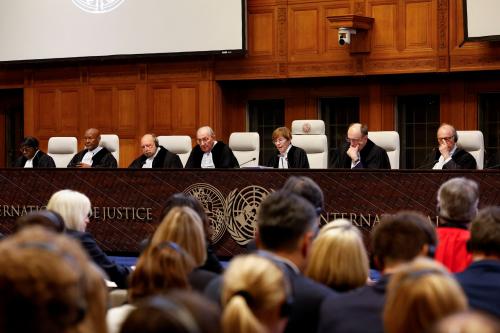It’s time to take Bill Clinton, his presidency, and his times seriously. Historians dithered before getting right with Reagan, letting their political and intellectual disdain discourage thoughtful scholarship for over two decades after his inauguration. The media’s obsession with both Clintons’ genuine character flaws, have disappointed and distracted too many chroniclers. Hillary Clinton’s ongoing political saga has added more confusion. Approaching the twenty-fifth anniversary of Clinton’s campaign launch, with Hillary Clinton running yet again for president—and sometimes running away from her husband’s presidency—with illuminating Clinton papers and oral histories now being released, it is time to examine Clinton clearly, seeing through the clouds of his own inconstancy and the constant media barrage, assessing his vision, policies, achievements, and synergy with the 1990s.
President Clinton was like that iconic Baby Boomer cartoon character Bugs Bunny, dodging disasters—many of his own making—outsmarting enemies, scoring victories, large and small. Clinton only won the presidency with 43 percent of the popular vote. He abandoned his signature health care reform months before Democrats lost the Congress for the first time since Dwight Eisenhower. He failed to break the 50 percent mark two years later in 1996. In 1998, he became the first elected president ever impeached. He left the country politically deadlocked.
Nevertheless, this indomitable, brilliant, raffish, never-say-die enchanter became the first Democratic president since Franklin Roosevelt to earn reelection. If Ronald Reagan’s presidency produced three Ps of peace, prosperity, and patriotism, Clinton’s presidency entailed four Ps of peace, prosperity, pluralism, and progress. Clinton benefited from governing after the Cold War ended and during America’s longest peacetime economic expansion, with 116 months of continuous growth generating 22 million new jobs. He presided over the Democratic Gilded Age, the twentieth century’s only peace-and-prosperity decade without Republicans in charge—and without Democrats in opposition tempering the excess.
Clinton forged a Third Way, continuing Reagan’s project of ending “the era of big government” with a leaner government, without abandoning the middle class, minorities, and the poor. Just as the Republican Dwight Eisenhower legitimized Franklin Roosevelt’s Democratic revolution, at times Clinton legitimized Reagan’s anti-Great-Society counterrevolution—while denying it, of course. Clinton’s communications director Don Baer says that “If the FDR project was about using government as a leveraging force on the market to make the market system ready for progress after World War II, Clinton offered the mirror image. He used market forces to temper government so it could become a more effective force for progress going into the twenty-first century.”
Particularly sensitive to the changes taking place, Clinton would describe his primary achievement as “He had to make America work in a new world.” Characteristically for Clinton and his age, this statement sounded more like a challenge partially unfulfilled, than a program fully realized. More concretely, his speechwriter Jeff Shesol says Clinton showed that “Government did not have to be big for it to be a catalyst for positive change in people’s lives.” Clinton’s ideological guru from the moderate Democratic Leadership Council, Al From, says Clinton “saved progressive politics, all over the world, by modernizing it.”
While demonizing Newt Gingrich as an “extremist,” Clinton would seize the new, Reaganized center as a deficit-cutting, crime-busting Good Father: a Reaganite with a bigger heart and more fiscal self-control. Clinton injected a Democratic twist with his Family Leave Act, support for abortion rights, and push for diversity. While worrying about the materialistic excess this Baby Boomer boom triggered, he saw a broadly distributed prosperity as mass-producing the dignity and middle-class values that would unite a multicultural America as the exemplary mass middle-class nation.
Clinton’s presidency was not as scandal-scarred as Richard Nixon’s, as star-crossed as Jimmy Carter’s, or as celebrated as John Kennedy’s. It was not as tumultuous as George W. Bush’s, as sobering as Barack Obama’s, or as transformational as Ronald Reagan’s. But it was unduly chaotic. Clinton’s manic-depressive presidency often operated in the awkward intersection between American politics at its most serious and American culture at its most absurd. As he sought to restructure the economy, reform health care, reinvent government, and reimagine America’s future, as he coped with foreign messes in Bosnia, China, Kosovo, Somalia, Israel, and Rwanda, he also had to protect himself from American popular culture’s gossip and his own moral failings.
Ultimately, Clinton shared responsibility for four disasters. Politically, as the 1990s began, “red” and “blue” were just colors. A decade later, many saw two Americas, what would be George W. Bush’s provincial, conservative, traditionalist Red America and Al Gore’s cosmopolitan, liberal, modernist Blue America. Culturally, Clinton’s behavior validated the immorality he denounced, feeding a growing moral panic. Internationally, his admitted “failure” to neutralize the arch terrorist Osama bin Laden fed the perfect storm of blunders that failed to prevent the mass murders of September 11, 2001. And economically, just as the good times of the 1980s and 1990s were a bipartisan achievement, the crash of 2008 would be a bipartisan failure, rooted in Clinton’s populist easy credit push to democratize home ownership by lowering mortgage standards and his elitist deregulatory rush to let Wall Street police itself. Clinton’s potholed presidency fed and reflected the Nineties’ querulous mood.
If in the 1980s Americans under Ronald Reagan looked back and, ultimately, reconciled with the Sixties’ revolutions, the 1990s involved looking forward and pioneering the new world all these technological transformations would generate. Although he spoke about it so often it became the stuff of caricature, Clinton was correct: America was building its bridge to the twenty-first century. In the final decade of this brutal, magical, centrifugal century, this brave, new, bewildered America was more alienating yet more welcoming. How Americans navigated those contradictions would shape those years, and still shapes our times today.
»Watch a webcast of Gil Troy and Brookings Fellow John Hudak’s discussion of the Clinton age here.
The Brookings Institution is committed to quality, independence, and impact.
We are supported by a diverse array of funders. In line with our values and policies, each Brookings publication represents the sole views of its author(s).



Commentary
A Bill Clinton balance sheet: Peace, prosperity, pluralism, and progress
December 3, 2015